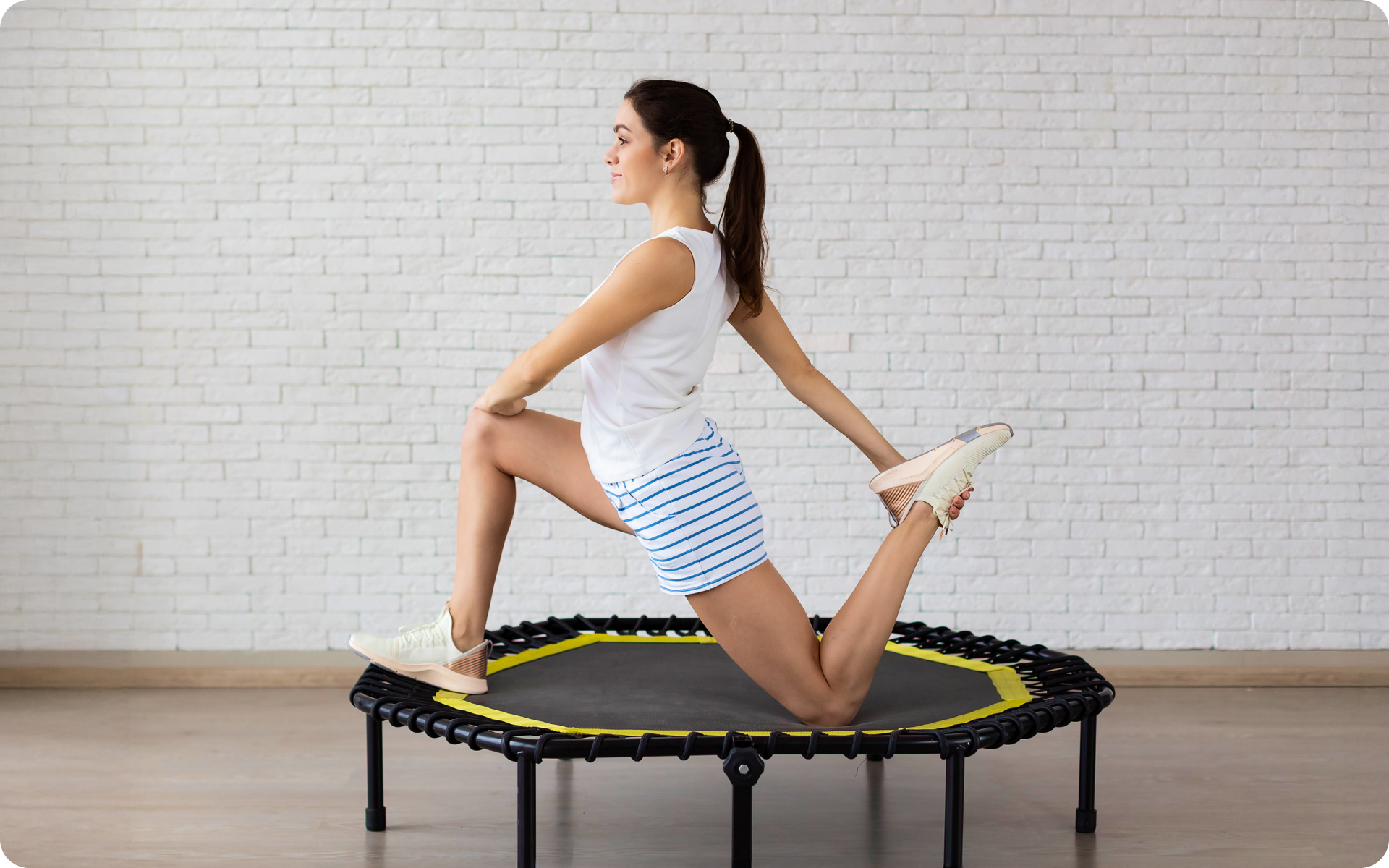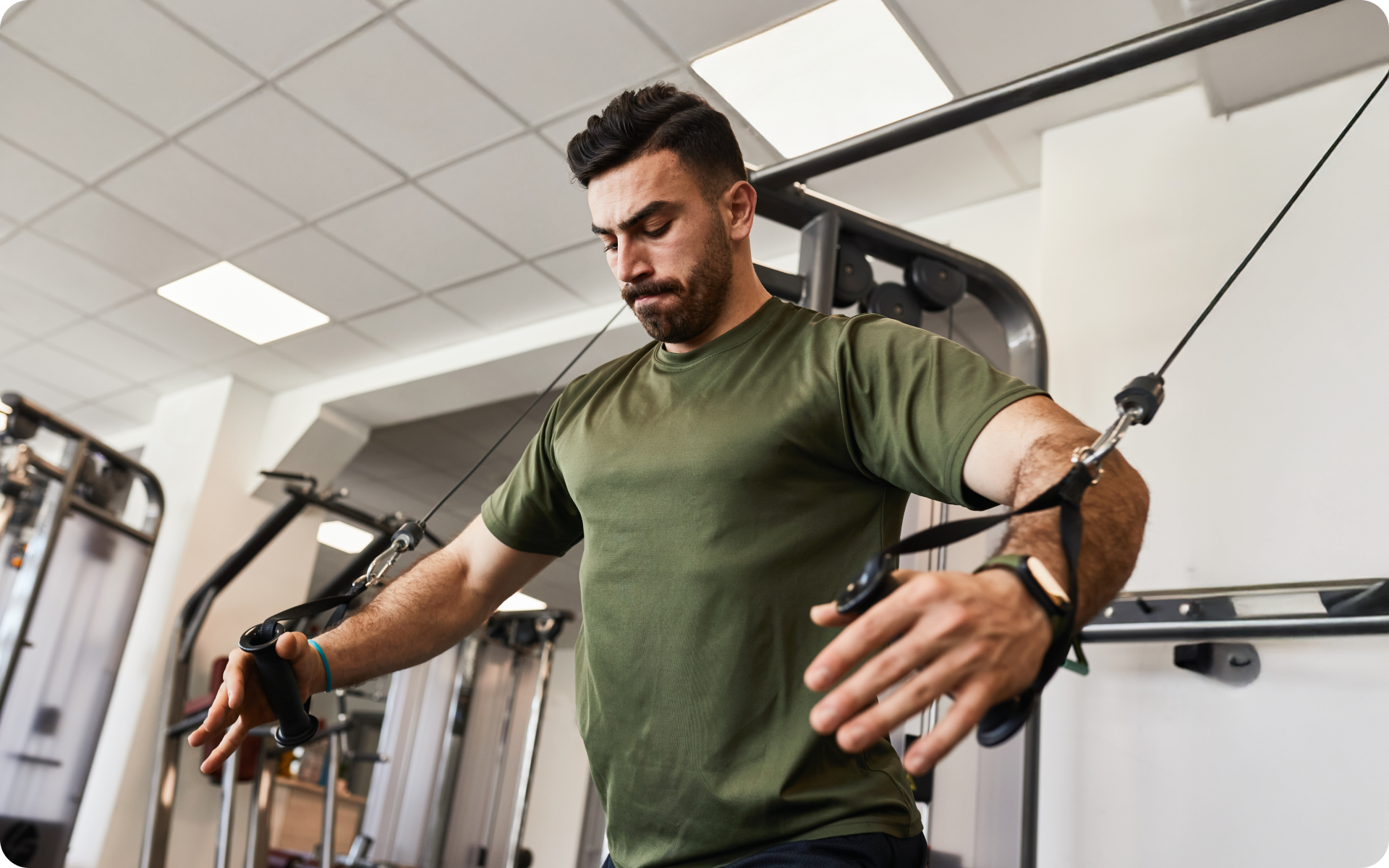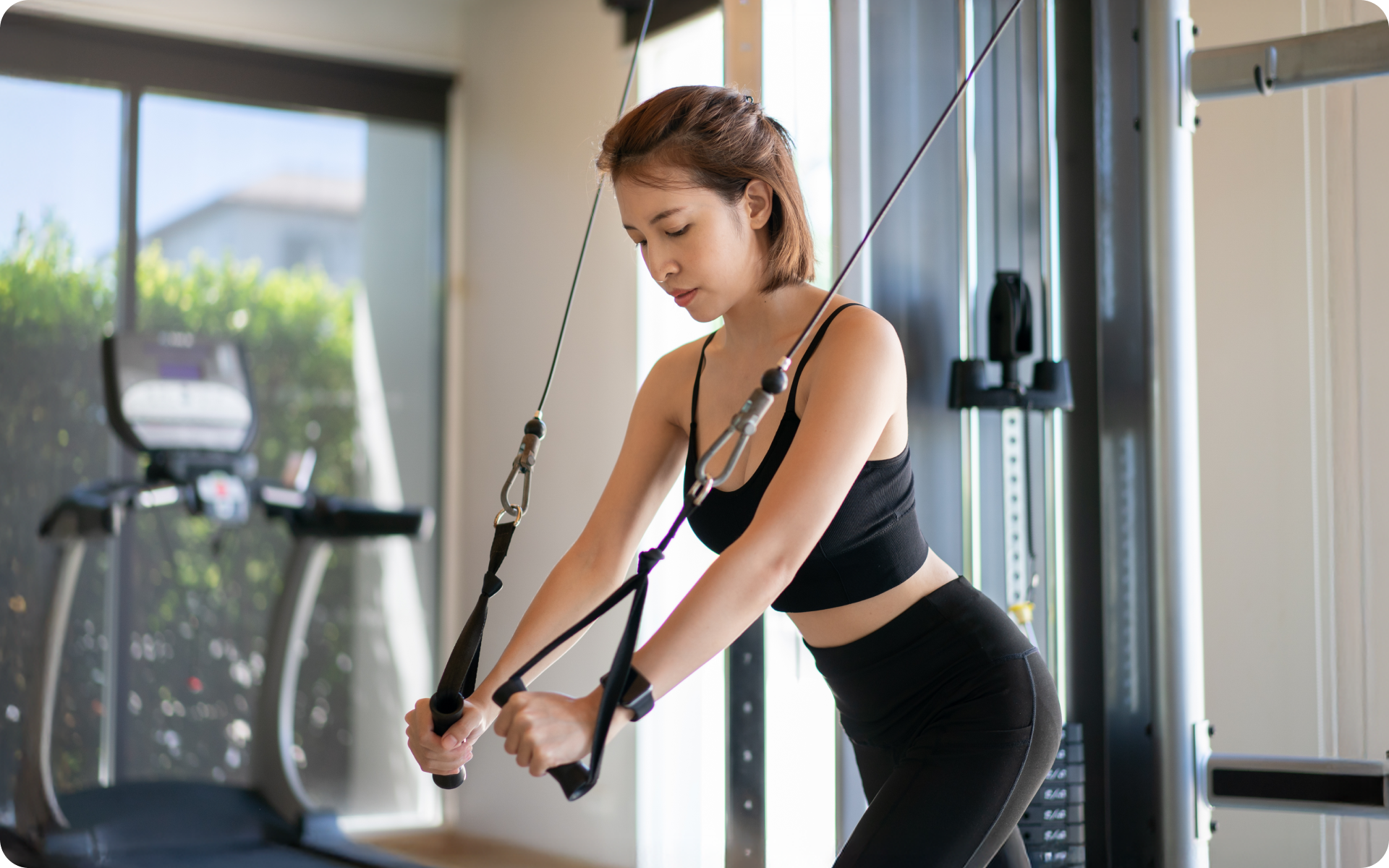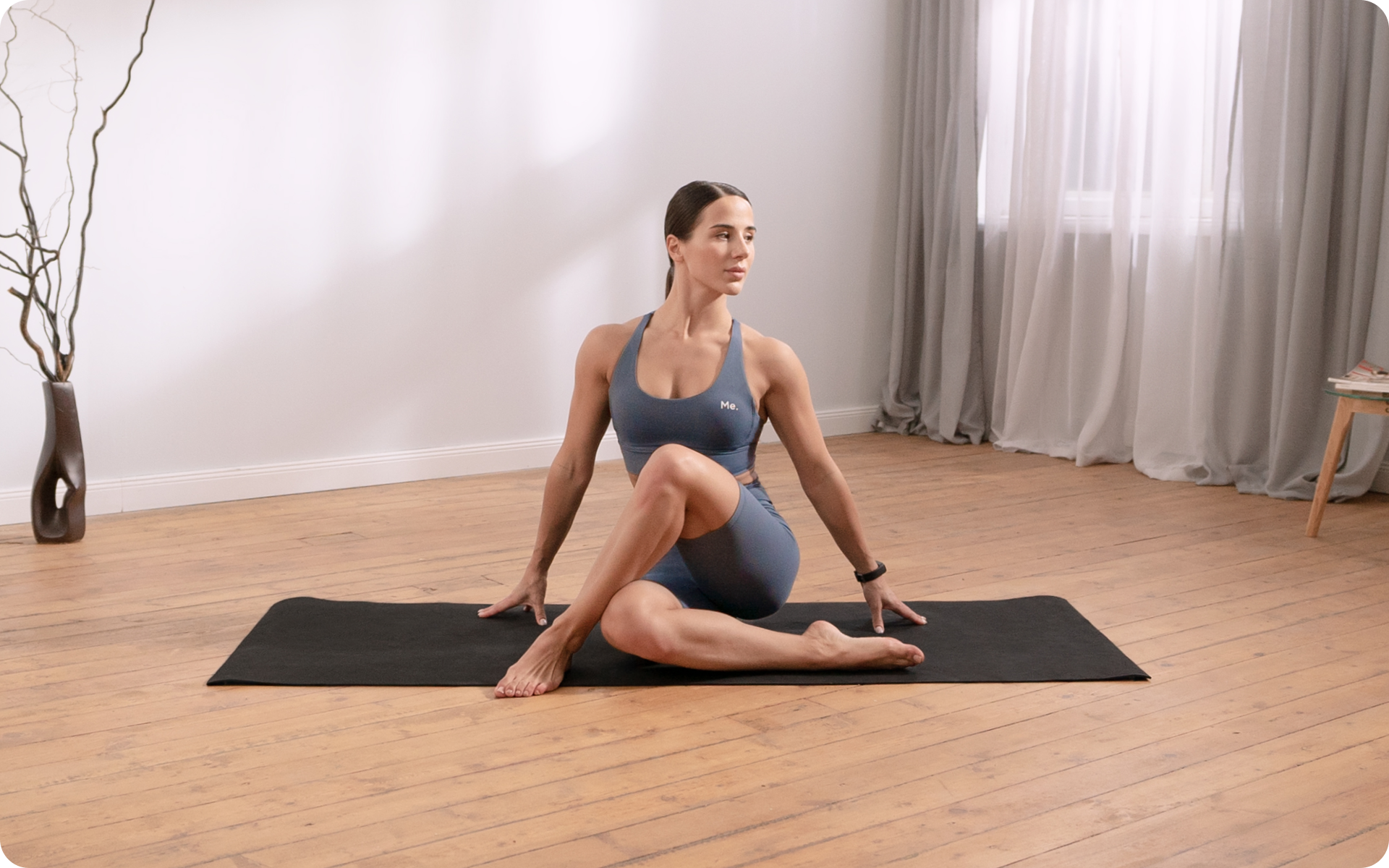Think trampolines are only suited for kids and backyard fun? You might want to think again! Believe it or not, rebounding (jumping on a mini-trampoline) is an excellent form of exercise for people of all ages.
When it comes to choosing an exercise, many consider the ease of starting and the potential of staying with the program. This is the first reason why rebounding is so great.
You can start slowly, at your own pace, and work up to a more vigorous workout. And you don’t need lots of special equipment or a gym membership – just a mini-trampoline and some comfortable clothing.
What Is Rebounding Exercise?
Rebounding is an aerobic exercise that is performed on a mini trampoline. It involves bounding up and down on the trampoline, sometimes with added movements such as jumping jacks or twists.
Originally, rebounding was done by astronauts to help them regain bone and muscle mass after being in space (9).
What happens during rebounding is that the body experiences differences of gravitational pulls as you go up and down on the trampoline. This movement creates a resistance effect, which has multiple benefits for health and fitness.
As far as equipment, all that is needed for rebounding exercise is a mini trampoline, also known as a rebounder. Rebounders are usually small enough to be stored and used in the home.
For your safety, you’ll want to use a quality rebounder that is sturdy with good construction. While it is important to find a high-quality rebounder, you don’t need to spend a fortune on one. In fact, many models can be found at an affordable price.
Reasons why BetterMe is a safe bet: a wide range of calorie-blasting workouts, finger-licking recipes, 24/7 support, challenges that’ll keep you on your best game, and that just scratches the surface! Start using our app and watch the magic happen.
Are Rebounds Healthy?
Rebounds (the act of jumping on a mini trampoline) is healthy because it is a weight-bearing exercise. This means that it puts pressure on your bones, which helps to keep them strong and healthy (1).
Bone health is an important aspect of overall health, especially as we age (14). Rebounding benefits for seniors, includes preventing conditions like osteoporosis and osteoarthritis.
Not only is rebounding great for your bones, but it also has many other benefits that you may not be aware of.
Here are 10 other rebounder benefits that may surprise you, and tips on how to get started.
1. Rebounding is Easy on the Joints
If you have joint pain or are concerned about impact exercise, rebounding is a great low-impact option. The trampoline’s surface absorbs some of the shocks as your feet land on the mat, making it easier on your knees, hips, and back.
2. Rebounding Can Help You Lose Weight
Weight loss comes down to burning more calories than you consume (8). And rebounding is an excellent way to rev up your calorie burn (4).
As you jump, your muscles have to work harder to control the up-and-down motion. This increased muscle activity means you’ll burn more calories both during and after your workout.
Additionally, this exercise may boost your metabolism and improve your resting metabolic rate. What does that mean? You’ll continue to burn calories at a higher rate even when you’re not working out.
Of course you’ll need to make other modifications to your diet and lifestyle to see lasting results (21). But rebounding can help give you the edge you need to reach your goals.
Explore more aerobic exercises at home for weight loss, in our previous posts.
3. Rebounding is a Total-Body Workout
Most forms of cardio only work the lower body. However, rebounding uses both the upper and lower body, making it a true full-body workout.
As you jump, your arms naturally swing to help generate momentum. This helps tone your upper-body muscles, including your shoulders, biceps, back, and core.
Our previous post – Anaerobic Exercise Vs Aerobic Exercise: What’s The Difference? Provides detailed information on moderate and high intensity workouts.
4. Rebounding is Great for Cardiorespiratory Health
Regular exercise is essential for maintaining a healthy heart. It not only helps reduce your risk of heart disease but can also improve your cholesterol levels and blood pressure (3).
Rebounding is an excellent cardio workout. As you jump, your heart rate will increase, and you’ll start to breathe heavier. Your body will also use more oxygen, which is great for overall cardiovascular health.
By lowering low-density lipoprotein and increasing high-density lipoprotein, rebounding can also help improve your cholesterol levels (12).
Your breathing capacity will also increase with regular cardio exercise. You’ll be able to take in more oxygen with each breath, which can help improve your endurance and stamina (22).
5. Rebounding Can Boost Your Mood
Exercise is a proven mood booster (6). And rebounding is no exception. The increase in heart rate and blood flow can help improve your energy levels and mental clarity.
This exercise also encourages blood circulation by increasing the capillary count in your muscles. This helps deliver more oxygen and nutrients to your cells, which can improve your energy levels (22).
Plus, the endorphins released during exercise can help reduce stress and anxiety (5).
6. Rebounding Can Help Improve Balance and Coordination
As you get older, your balance and coordination may start to decline (2). This can make everyday activities like walking or climbing stairs more difficult.
And it’s not only older adults who are at risk – not moving your body can lead to a loss of muscle mass and bone density, which can make you more susceptible to falls.
Rebounding helps improve balance and coordination by improving your brain’s responsiveness to the vestibular system. This system is responsible for your sense of balance and helps you keep your body upright (10).
By improving coordination between the proprioceptors in the joints and enhancing the transmission of signals to the brain, rebounding can help you stay balanced and coordinated.
Read more: Beginner Workout for Lower Butt (Exercises, Sample Routine and More)
7. Rebounding Can Aid Lymphatic Circulation
The lymphatic system is a network of organs, nodes, and vessels that helps remove toxins, waste, and other unwanted material from the body. This system relies on the movement of muscles to circulate lymph fluid (13).
Rebounding can help move this fluid and improve circulation. As you jump, the contraction of your muscles helps pump lymph fluid through your body. This increased circulation can help remove toxins and waste from your cells, which can improve your overall health (18).
8. Rebounding Strengthens Your Musculoskeletal System
Your musculoskeletal system is made up of your bones, joints, muscles, ligaments, and tendons. This system supports your body and allows you to move.
Rebounding helps strengthen this system by improving bone density and joint health. Jumping increases the gravitational load on your bones, which helps stimulate the production of new bone cells (16). This can help reduce the risk of osteoporosis and other age-related diseases.
Jumping also helps improve the shock-absorbing capabilities and lubrication of your joints. This can help reduce the impact of jarring movements and prevent joint damage.
Strengthening the musculoskeletal system can slow down atrophy, which is the loss of muscle mass and bone density (14). This can help you stay active and independent as you age.
9. Rebounding Can Boost Your Immune System
Regular exercise has been shown to boost the immune system (19). And rebounding is no exception. This exercise can help improve circulation, which helps deliver more oxygen and nutrients to cells. It can also help remove toxins and waste from your body, since it improves lymphatic circulation.
The increased circulation and removal of toxins can help improve your body’s ability to fight infection. This can help you stay healthy and reduce your risk of developing illnesses.
10. Rebounding Can Improve Digestion
The effects of exercise on the digestive system depend on several factors, including the type of exercise being performed, the intensity of the activity, and an individual’s digestive health. In general, moderate exercise is more likely to be beneficial than strenuous exercise.
Rebounding on a mini-trampoline is a fun, easy way to get some gentle exercise while improving your digestion.
There are a few different ways that exercise can positively affect digestion. Consistent exercise can improve blood flow to the digestive organs, which can help to keep things moving along (17).
Second, exercise can help to strengthen muscles in the digestive tract, which can help to move food through the system more efficiently. Finally, exercise can promote a healthy gut bacteria balance, which can lead to better overall digestion (7).
While exercise can have some positive effects on the digestive system, it’s important to be aware of the potential downside as well. Strenuous exercise can lead to gastrointestinal problems like diarrhea or indigestion (20).
Who Should Not Do Rebounding?
People who shouldn’t rebound include those with a heart condition, joint problems, or severe vertigo. If you’re under medical supervision for any other conditions, check with your doctor before starting this exercise.
Those With a Heart Condition
Rebounding involves jumping, which can cause your heart rate to increase. If you have a heart condition, it’s essential to exercise at an intensity level that is appropriate for your health. Speak with your doctor before starting any new exercise program.
Those With Joint Problems
Rebounding involves repetitive bouncing, which can be hard on the joints. If you have joint problems like arthritis or chronic pain, consult with your doctor before attempting this exercise. You may need to modify specific movements or choose a different type of low-impact exercise.
Those With Severe Vertigo
Vertigo is a condition that causes dizziness and loss of balance. Rebounding can aggravate these symptoms, making it unsafe for those with severe vertigo. It’s best to speak with your doctor before attempting this exercise if you have vertigo.
Pregnant Women
Women who are pregnant should avoid rebounding, especially during the later stages of pregnancy. This exercise can put additional pressure on the abdomen, which can be uncomfortable and unsafe for both the mother and baby.
Note – it’s not totally off-limits to rebound when pregnant, but it’s essential to consult with your doctor before doing so. They can advise you on how to modify the exercise and ensure you’re being safe for you and your baby.
BetterMe app will provide you with a host of fat-frying fitness routines that’ll scare the extra pounds away and turn your body into a masterpiece! Get your life moving in the right direction with BetterMe!
How to Get Started With Rebounding
If you’re interested in trying rebounding, there are a few things you need to know before you get started.
First, make sure you have the right equipment. You’ll need a rebounder – also known as a mini trampoline – and a mat to protect your floor. You can find rebounders and mats at most sporting goods stores.
The ideal rebounder is one that is made of sturdy materials and has a spring-loaded frame. Quiet performance is also a must, as you don’t want to disturb your neighbors.
Second, clear an area in your home where you can safely rebound. You’ll need enough space to jump without hitting anything. If you’re short on space, a foldable rebounder is a good option.
Third, you’ll learn the basic bouncing technique:
- Start by standing in the center of the rebounder with your feet shoulder-width apart.
- Bend your knees and lower your hips into a quarter squat.
- From here, jump straight up into the air. As you land, bend your knees to absorb the impact. Then immediately jump again.
- Vary your movements to keep your body guessing. You can try different jumping patterns, such as side-to-side, front-to-back, or circles.
You may want to consider a group class or personal training session to learn proper form and technique. Rebounding is a low-impact exercise, but you still need to use proper form to avoid injury.
Fourth, prepare a routine. You can find a variety of rebounder routines online or in exercise books. Or you can create your routine based on your fitness goals. Following a consistent routine will help you see results faster.
Finally, start slow and gradually increase the intensity of your workout as you get more comfortable with rebounding. It’s important to listen to your body and not overdo it.
Techniques That Will Keep You Injury-Free
Rebounding is a low-impact exercise, but you can still get injured if you don’t use proper form. Here are a few tips to help you stay safe while rebounding:
Start Out with Handlebars
Don’t overestimate your balance. If you’re a beginner, start by using the handlebars to help you keep your balance. As you get more comfortable, you can try rebounding without them.
Wear Proper Footwear
Make sure you wear supportive, shock-absorbent shoes. Running shoes or cross-trainers are ideal. Avoid shoes with hard soles, such as court shoes.
Keep Your Body Loose
Don’t tense up your muscles while you’re rebounding. This can put unnecessary strain on your joints and muscles. Instead, keep your body moderately relaxed and let the rebounder do the work.
Land Softly
When you land, bend your knees slightly to absorb the impact. Try to land softly on your mid-foot or ball of your foot. Avoid landing on your heel, as this can put stress on your knees.
Avoid High-Impact Moves
High-impact moves, such as double jumps or flips, can jar your body and lead to injury. Stick to low-impact moves until you’re comfortable with rebounding.
Beware of Overuse Injuries
Like any exercise, rebounding can lead to overuse injuries if you do the same moves repetitively for every workout (15). To avoid this, vary your routine frequently. This will help keep your muscles and joints from getting too sore.
Stop If You Feel Pain
If you start to feel pain, stop immediately and rest. Rebounding is a low-impact exercise, but it’s still possible to overdo it. Listen to your body and take breaks when you need them.
Read more: Workout For Lower Butt: Exercises For A Firmer, Perkier Bum
The Bottom Line
Rebounding is a great way to get fit. It’s low-impact, so it’s easy on your joints. It’s also an effective cardio workout that can help you burn calories and improve your cardiovascular health. Plus, it’s a fun way to exercise.
Be sure to use proper form to avoid injury. And start slowly, gradually increasing the intensity of your workouts as you get more comfortable with rebounding.
DISCLAIMER:
This article is intended for general informational purposes only and does not serve to address individual circumstances. It is not a substitute for professional advice or help and should not be relied on for making any kind of decision-making. Any action taken as a direct or indirect result of the information in this article is entirely at your own risk and is your sole responsibility.
BetterMe, its content staff, and its medical advisors accept no responsibility for inaccuracies, errors, misstatements, inconsistencies, or omissions and specifically disclaim any liability, loss or risk, personal, professional or otherwise, which may be incurred as a consequence, directly or indirectly, of the use and/or application of any content.
You should always seek the advice of your physician or other qualified health provider with any questions you may have regarding a medical condition or your specific situation. Never disregard professional medical advice or delay seeking it because of BetterMe content. If you suspect or think you may have a medical emergency, call your doctor.
SOURCES:
- 9 Reasons You Should Add A Trampoline To Your Fitness Routine (2023, healthdigest.com)
- Balance and Aging (2009, onlinelibrary.wiley.com)
- Cardiovascular Effects and Benefits of Exercise (2018, frontiersin.org)
- Effect of Rebound Exercises in Overweight Individuals on BMI, Waist-Hip Ratio and Lung Functions : Randomized Control Trial (2018, academia.edu)
- Effects of Exercise and Physical Activity on Anxiety (2013, frontiersin.org)
- Exercise for Mental Health (2006, ncbi.nlm.nih.gov)
- Exercise influence on the microbiome–gut–brain axis (2019, ncbi.nlm.nih.gov)
- Fat loss depends on energy deficit only, independently of the method for weight loss (2007, pubmed.ncbi.nlm.nih.gov)
- Guide to Trampoline Workout: Why Rebounding Is the Best At-Home Exercise (2023, vogue.com)
- How does our sense of balance work? (2010, ncbi.nlm.nih.gov)
- How much physical activity do adults need? (2022, cdc.gov)
- Influence of a mini-trampoline rebound exercise program on insulin resistance, lipid profile and central obesity in individuals with type 2 diabetes (2018, pubmed.ncbi.nlm.nih.gov)
- Lymphatic System Flows (2019, ncbi.nlm.nih.gov)
- Muscle and Bone Mass Loss in the Elderly Population: Advances in diagnosis and treatment (2018, ncbi.nlm.nih.gov)
- Overtraining Syndrome (2012, ncbi.nlm.nih.gov)
- Physical Activity and Bone Health (2014, ncbi.nlm.nih.gov)
- Potential benefits and hazards of physical activity and exercise on the gastrointestinal tract (2001, ncbi.nlm.nih.gov)
- Regulation of Increased Blood Flow (Hyperemia) to Muscles During Exercise: A Hierarchy of Competing Physiological Needs (2015, journals.physiology.org)
- The compelling link between physical activity and the body’s defense system (2019, sciencedirect.com)
- The impact of physical exercise on the gastrointestinal tract (2009, pubmed.ncbi.nlm.nih.gov)
- Weight-Loss and Maintenance Strategies – Weight Management (2004, ncbi.nlm.nih.gov)
- Your lungs and exercise (2016, ncbi.nlm.nih.gov)










